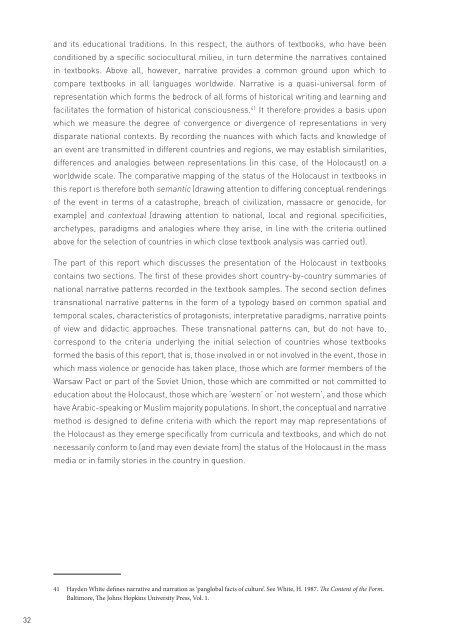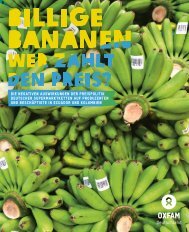228776e
228776e
228776e
Create successful ePaper yourself
Turn your PDF publications into a flip-book with our unique Google optimized e-Paper software.
and its educational traditions. In this respect, the authors of textbooks, who have been<br />
conditioned by a specific sociocultural milieu, in turn determine the narratives contained<br />
in textbooks. Above all, however, narrative provides a common ground upon which to<br />
compare textbooks in all languages worldwide. Narrative is a quasi-universal form of<br />
representation which forms the bedrock of all forms of historical writing and learning and<br />
facilitates the formation of historical consciousness. 41 It therefore provides a basis upon<br />
which we measure the degree of convergence or divergence of representations in very<br />
disparate national contexts. By recording the nuances with which facts and knowledge of<br />
an event are transmitted in different countries and regions, we may establish similarities,<br />
differences and analogies between representations (in this case, of the Holocaust) on a<br />
worldwide scale. The comparative mapping of the status of the Holocaust in textbooks in<br />
this report is therefore both semantic (drawing attention to differing conceptual renderings<br />
of the event in terms of a catastrophe, breach of civilization, massacre or genocide, for<br />
example) and contextual (drawing attention to national, local and regional specificities,<br />
archetypes, paradigms and analogies where they arise, in line with the criteria outlined<br />
above for the selection of countries in which close textbook analysis was carried out).<br />
The part of this report which discusses the presentation of the Holocaust in textbooks<br />
contains two sections. The first of these provides short country-by-country summaries of<br />
national narrative patterns recorded in the textbook samples. The second section defines<br />
transnational narrative patterns in the form of a typology based on common spatial and<br />
temporal scales, characteristics of protagonists, interpretative paradigms, narrative points<br />
of view and didactic approaches. These transnational patterns can, but do not have to,<br />
correspond to the criteria underlying the initial selection of countries whose textbooks<br />
formed the basis of this report, that is, those involved in or not involved in the event, those in<br />
which mass violence or genocide has taken place, those which are former members of the<br />
Warsaw Pact or part of the Soviet Union, those which are committed or not committed to<br />
education about the Holocaust, those which are ‘western’ or ‘not western’, and those which<br />
have Arabic-speaking or Muslim majority populations. In short, the conceptual and narrative<br />
method is designed to define criteria with which the report may map representations of<br />
the Holocaust as they emerge specifically from curricula and textbooks, and which do not<br />
necessarily conform to (and may even deviate from) the status of the Holocaust in the mass<br />
media or in family stories in the country in question.<br />
41 Hayden White defines narrative and narration as ‘panglobal facts of culture’. See White, H. 1987. The Content of the Form.<br />
Baltimore, The Johns Hopkins University Press, Vol. 1.<br />
32




